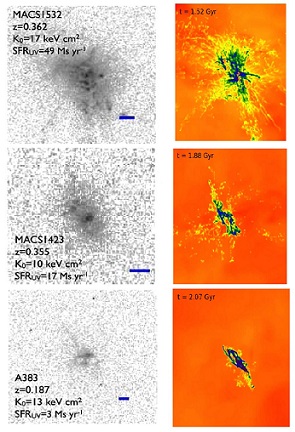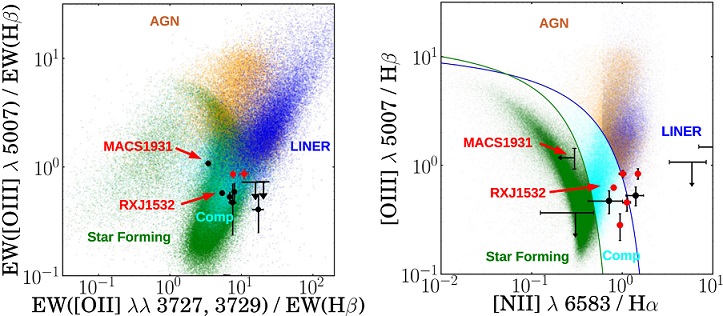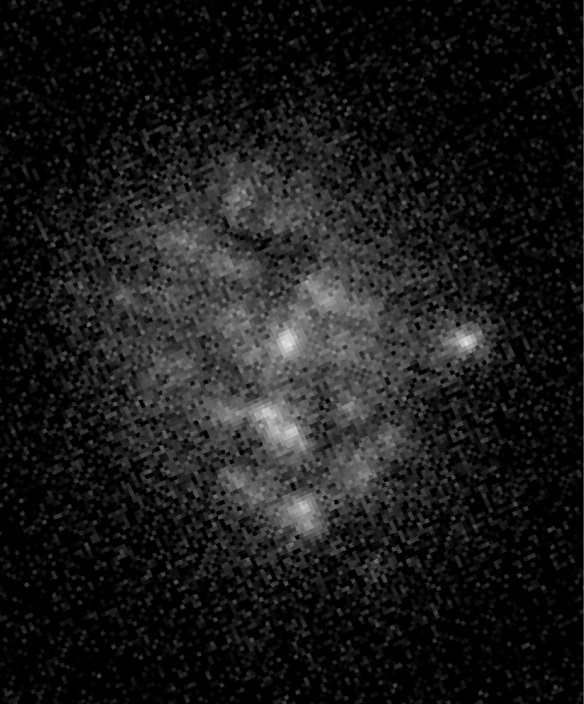Star Formation in Brightest Cluster Galaxies
Relevant Works: Donahue, Connor et al., 2017; Donahue, Connor et al., 2015; Fogarty, Postman, Connor et al., 2015
In general, galaxies in clusters are red, dead, and elliptical (see Connor et al., 2019a). This should be even more true for brightest cluster galaxies (BCGs), which are at the bottom of the cluster's potential, and should therefore be unable to get any star formation going. However, a large number of BCGs show signs of ongoing and active star formation. The most prominent example of this is the Phoenix cluster, where the BCG is forming around 740 Solar masses of stars per year (McDonald et al, 2012).
What is happening here is that the hot gas atmosphere of the cluster is glowing in X-rays -- this means that there is a significant amount of energy being radiated in X-ray wavelengths, so that the gas is cooling. When the gas cools, it falls in toward the cluster center, and the cool gas collapses into knots of star formation. The lack of star formation in most BCGs is evidence of some counteracting force, that prevents the cooling gas from collapsing in most clusters.
Deeper X-ray observations of clusters in the early millennium showed that the intracluster medium is being heated through mechanical feedback from the BCG's central black hole. Similarly, X-ray and UV results showed that cooling is highly supressed for high temperature gas and mostly supressed for low temperature gas. The combination of these factors then paints a picture: the central black hole (referred to as the AGN) drives feedback in the cluster atmosphere that reduces the cooling of hot gas. As this infall is needed to sustain the AGN, and since a too-powerful AGN would blow out cooling clumps, these forces must be in some sort of balance (there are too many papers on this topic to cite, but see works by e.g., Voit et al., 2014; Gaspari et al., 2018; and McDonald et al., 2018 -- and references within).
 There were three works that I was involved in that looked at
the brighest cluster galaxies in the CLASH sample. In the first
paper, we looked at the UV properties of a sample of CLASH BCGs.
While all the BCGs were detected in UV -- as even evolved stellar
populations produce UV light -- a sample of them demonstrated
up to 80 Solar masses per year of star formation in their UV
diagnostics. We also compared the morphologies of these galaxies
to simulations of AGN feedback by Li & Bryan 2014a and Li & Bryan 2014b. A subset of these comparisons are shown to the right.
The Li & Bryan simulations showed a morphological progression during a cycle
of AGN feedback and condensation, and we showed that the observed UV
morphologies were consistent with views of this cycle at different points
in its progression. Soon after, a similar analysis of low-redshift
BCGs was published by Tremblay et al. (2015), providing further evidence for the UV
morphology of these highly-starforming BCGs being described by
simulations of AGN feedback.
There were three works that I was involved in that looked at
the brighest cluster galaxies in the CLASH sample. In the first
paper, we looked at the UV properties of a sample of CLASH BCGs.
While all the BCGs were detected in UV -- as even evolved stellar
populations produce UV light -- a sample of them demonstrated
up to 80 Solar masses per year of star formation in their UV
diagnostics. We also compared the morphologies of these galaxies
to simulations of AGN feedback by Li & Bryan 2014a and Li & Bryan 2014b. A subset of these comparisons are shown to the right.
The Li & Bryan simulations showed a morphological progression during a cycle
of AGN feedback and condensation, and we showed that the observed UV
morphologies were consistent with views of this cycle at different points
in its progression. Soon after, a similar analysis of low-redshift
BCGs was published by Tremblay et al. (2015), providing further evidence for the UV
morphology of these highly-starforming BCGs being described by
simulations of AGN feedback.
 The second CLASH BCG work I was involved in focused on measuring the star
formation activity through optical diagnostics. Using Hα
measurements from the photometry and Hβ, [O II], and [O III]
values from SOAR longslit spectra, we investigated the source of
ionizing photons in these BCGs using diagnostic diagrams, as shown in
the image to the left. While there is some LINER activity, much of
the ionization comes in the region expected for star formation,
particularly for the strongest star-forming galaxies in the sample.
The second CLASH BCG work I was involved in focused on measuring the star
formation activity through optical diagnostics. Using Hα
measurements from the photometry and Hβ, [O II], and [O III]
values from SOAR longslit spectra, we investigated the source of
ionizing photons in these BCGs using diagnostic diagrams, as shown in
the image to the left. While there is some LINER activity, much of
the ionization comes in the region expected for star formation,
particularly for the strongest star-forming galaxies in the sample.
 Finally, this team investigated the BCG of RX J1532.9+3021. On the
right we show the view of this BCG in UV -- a series of bright knots
are visible; these are about 0.5 arcseconds in diameter, or 2 kpc
at this redshift. Taken with the COS finder camera, these are the
the highest-resolution images of these features, and what looked
like four bright point-like sources is revealed to be more of a blend
of diffuse sources instead. We obtained STIS and COS spectra of
these knots taht covered Hα and Lyα, respectively.
While promient Lyα emission is seen, signatures of
cooling -- O VI, C IV -- are absent. What we take from this is
that strong star formation is ongoing, but cooling is relatively
minimal. In contrast to other highly star-forming BCGs, this makes
the BCG of RX J1532.9+3021 an example of a different part of the
AGN feedback cycle, and that in this cycle star formation does
not directly track accretion. With further UV spectra of BCGs,
we can potentially reveal an ensemble of states with accretion
and cooling not acting in unison.
Finally, this team investigated the BCG of RX J1532.9+3021. On the
right we show the view of this BCG in UV -- a series of bright knots
are visible; these are about 0.5 arcseconds in diameter, or 2 kpc
at this redshift. Taken with the COS finder camera, these are the
the highest-resolution images of these features, and what looked
like four bright point-like sources is revealed to be more of a blend
of diffuse sources instead. We obtained STIS and COS spectra of
these knots taht covered Hα and Lyα, respectively.
While promient Lyα emission is seen, signatures of
cooling -- O VI, C IV -- are absent. What we take from this is
that strong star formation is ongoing, but cooling is relatively
minimal. In contrast to other highly star-forming BCGs, this makes
the BCG of RX J1532.9+3021 an example of a different part of the
AGN feedback cycle, and that in this cycle star formation does
not directly track accretion. With further UV spectra of BCGs,
we can potentially reveal an ensemble of states with accretion
and cooling not acting in unison.
In addition to BCGs, the presence of star-forming regions -- or large Hα filaments -- is also seen in giant elliptical galaxies. I have been involved in a project to study these systems, mostly using longslit spectroscopy and narrow-band imaging on SOAR. This work has been a part of Werner et al., 2014; Lakhchaura et al., 2018; Juráñová et al., 2019; Grossová et al., 2019; and several upcoming papers. I expect to have more to say about these systems in the next year or so!